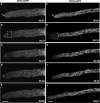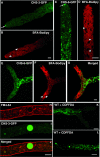Spitzenkorper localization and intracellular traffic of green fluorescent protein-labeled CHS-3 and CHS-6 chitin synthases in living hyphae of Neurospora crassa
- PMID: 17644657
- PMCID: PMC2043383
- DOI: 10.1128/EC.00088-07
Spitzenkorper localization and intracellular traffic of green fluorescent protein-labeled CHS-3 and CHS-6 chitin synthases in living hyphae of Neurospora crassa
Abstract
The subcellular location and traffic of two selected chitin synthases (CHS) from Neurospora crassa, CHS-3 and CHS-6, labeled with green fluorescent protein (GFP), were studied by high-resolution confocal laser scanning microscopy. While we found some differences in the overall distribution patterns and appearances of CHS-3-GFP and CHS-6-GFP, most features were similar and were observed consistently. At the hyphal apex, fluorescence congregated into a conspicuous single body corresponding to the location of the Spitzenkörper (Spk). In distal regions (beyond 40 microm from the apex), CHS-GFP revealed a network of large endomembranous compartments that was predominantly comprised of irregular tubular shapes, while some compartments were distinctly spherical. In the distal subapex (20 to 40 microm from the apex), fluorescence was observed in globular bodies that appeared to disintegrate into vesicles as they advanced forward until reaching the proximal subapex (5 to 20 microm from the apex). CHS-GFP was also conspicuously found delineating developing septa. Analysis of fluorescence recovery after photobleaching suggested that the fluorescence of the Spk originated from the advancing population of microvesicles (chitosomes) in the subapex. The inability of brefeldin A to interfere with the traffic of CHS-containing microvesicles and the lack of colocalization of CHS-GFP with the endoplasmic reticulum (ER)-Golgi body fluorescent dyes lend support to the idea that CHS proteins are delivered to the cell surface via an alternative route distinct from the classical ER-Golgi body secretory pathway.
Figures







Similar articles
-
Traffic of chitin synthase 1 (CHS-1) to the Spitzenkörper and developing septa in hyphae of Neurospora crassa: actin dependence and evidence of distinct microvesicle populations.Eukaryot Cell. 2011 May;10(5):683-95. doi: 10.1128/EC.00280-10. Epub 2011 Feb 4. Eukaryot Cell. 2011. PMID: 21296914 Free PMC article.
-
Functional stratification of the Spitzenkörper of Neurospora crassa.Mol Microbiol. 2009 Dec;74(5):1044-53. doi: 10.1111/j.1365-2958.2009.06917.x. Epub 2009 Oct 15. Mol Microbiol. 2009. PMID: 19843220
-
Imaging the secretory compartments involved in the intracellular traffic of CHS-4, a class IV chitin synthase, in Neurospora crassa.Fungal Genet Biol. 2018 Aug;117:30-42. doi: 10.1016/j.fgb.2018.03.006. Epub 2018 Mar 27. Fungal Genet Biol. 2018. PMID: 29601947
-
Fluorescent proteins illuminate the structure and function of the hyphal tip apparatus.Fungal Genet Biol. 2011 Sep;48(9):849-57. doi: 10.1016/j.fgb.2011.02.004. Epub 2011 Mar 22. Fungal Genet Biol. 2011. PMID: 21362491 Review.
-
Off the wall: The rhyme and reason of Neurospora crassa hyphal morphogenesis.Cell Surf. 2019 Mar 8;5:100020. doi: 10.1016/j.tcsw.2019.100020. eCollection 2019 Dec. Cell Surf. 2019. PMID: 32743136 Free PMC article. Review.
Cited by
-
Dissecting Cellular Function and Distribution of β-Glucosidases in Trichoderma reesei.mBio. 2021 May 11;12(3):e03671-20. doi: 10.1128/mBio.03671-20. mBio. 2021. PMID: 33975944 Free PMC article.
-
Fungal Morphogenesis, from the Polarized Growth of Hyphae to Complex Reproduction and Infection Structures.Microbiol Mol Biol Rev. 2018 Apr 11;82(2):e00068-17. doi: 10.1128/MMBR.00068-17. Print 2018 Jun. Microbiol Mol Biol Rev. 2018. PMID: 29643171 Free PMC article. Review.
-
Septum development in Neurospora crassa: the septal actomyosin tangle.PLoS One. 2014 May 6;9(5):e96744. doi: 10.1371/journal.pone.0096744. eCollection 2014. PLoS One. 2014. PMID: 24800890 Free PMC article.
-
Cytolocalization of the class V chitin synthase in the yeast, hyphal and sclerotic morphotypes of Wangiella (Exophiala) dermatitidis.Fungal Genet Biol. 2009 Jan;46(1):28-41. doi: 10.1016/j.fgb.2008.10.004. Epub 2008 Oct 21. Fungal Genet Biol. 2009. PMID: 18992354 Free PMC article.
-
Class III chitin synthase ChsB of Aspergillus nidulans localizes at the sites of polarized cell wall synthesis and is required for conidial development.Eukaryot Cell. 2009 Jul;8(7):945-56. doi: 10.1128/EC.00326-08. Epub 2009 May 1. Eukaryot Cell. 2009. PMID: 19411617 Free PMC article.
References
-
- Amnuaykanjanasin, A., and L. Epstein. 2006. A class Vb chitin synthase in Colletotrichum graminicola is localized in the growing tips of multiple cell types, in nascent septa, and during septum conversion to an end wall after hyphal breakage. Protoplasma 227:155-164. - PubMed
-
- Bartnicki-Garcia, S. 1968. Cell wall chemistry, morphogenesis and taxonomy of fungi. Annu. Rev. Microbiol. 22:87-107. - PubMed
-
- Bartnicki-Garcia, S. 2006. Chitosomes: past, present and future. FEMS Yeast Res. 6:957-965. - PubMed
-
- Bartnicki-Garcia, S. 2002. Hyphal tip growth: outstanding questions, p. 29-58. In H. D. Osiewacz (ed.), Molecular biology of fungal development. Marcel Dekker, Inc., New York, NY.
-
- Bartnicki-Garcia, S. 1990. Role of vesicles in apical growth and a new mathematical model of hyphal morphogenesis, p. 211-232. In I. B. Heath (ed.), Tip growth in plant and fungal cells. Academic Press, San Diego, CA.
Publication types
MeSH terms
Substances
LinkOut - more resources
Full Text Sources
Miscellaneous

